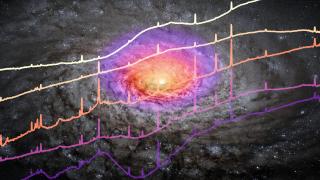Bibcode
Gómez-Guijarro, Carlos; González-Martín, Omaira; Ramos Almeida, C.; Rodríguez-Espinosa, J. M.; Gallego, Jesús
Bibliographical reference
Monthly Notices of the Royal Astronomical Society, Volume 469, Issue 3, p.2720-2736
Advertised on:
8
2017
Citations
21
Refereed citations
19
Description
Several studies of nearby active galactic nuclei (AGNs) have shown that
the soft X-ray emission presents a size and morphology resembling that
of the narrow-line region (NLR) traced by [O III]. Since the NLR is
mainly constituted by gas photoionized by the AGN, it seems logical to
assume that this is also the primary source of the soft X-ray emission.
However, these results are based on individual sources or small samples,
particularly focused on type-2 Seyfert galaxies. Very little has been
said concerning other types of AGNs. The purpose of this work is to
compare the circumnuclear morphologies of soft X-ray and [O III] images
to test whether they match in different optical classes of AGNs. Our
sample is composed of 27 AGNs: 9 type-1 Seyferts, 10 type-2 Seyferts and
8 low-ionization nuclear emission-line regions (LINERs). We find a good
match in 100 per cent of the type-2 Seyferts in our sample. This
correspondence is less frequent in type-1 Seyferts (22 per cent) and it
is not seen in LINERs. The good resemblance in type-2 Seyferts
constitutes evidence for a common physical origin. We argue that the
lack of correspondence in type-1 Seyferts might be due to the line of
sight perpendicular to the accretion disc. Based on the morphologies of
the eight LINERs in our sample, we discard a common origin for the soft
X-ray and [O III] emissions in these objects. Regarding the X-ray
properties, both high column density and hard X-ray luminosity are
associated with matched morphologies.
Related projects

Starbursts in Galaxies GEFE
Starsbursts play a key role in the cosmic evolution of galaxies, and thus in the star formation (SF) history of the universe, the production of metals, and the feedback coupling galaxies with the cosmic web. Extreme SF conditions prevail early on during the formation of the first stars and galaxies, therefore, the starburst phenomenon constitutes a
Casiana
Muñoz Tuñón

Nuclear Activity in Galaxies: a 3D Perspective from the Nucleus to the Outskirts
This project consists of two main research lines. First, the study of quasar-driven outflows in luminous and nearby obscured active galactic nuclei (AGN) and the impact that they have on their massive host galaxies (AGN feedback). To do so, we have been granted time with the Gran Telescopio CANARIAS (GTC) in the optical and near-infrared ranges
Cristina
Ramos Almeida